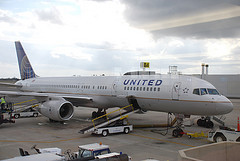United Says Photographing Staff Could Get You On 'No Fly' List, Continental Says You Deserve An Apology

(afagen)
Though United Airlines and Continental have been married for the better part of a year, the newlyweds haven’t begun to see eye-to-eye on everything. Take, for instance, a customer’s right to photograph a staffer’s name tag. United says it could get you banned from the airline and put on a “no fly” list, while Continental says that’s just not so.
This tale of bickering spouses comes to us from Consumerist reader Helen, who recently traveled with her family on United/Continental to Costa Rica. While checking their bags at the airport in Houston, Helen says the baggage line was understaffed and that those who were on hand were unhelpful.
So to document one staffer’s name for the purpose of filing a future complaint, Helen snapped a photo with her cellphone.
We’ll let Helen tell the story from here:
A minute later, we noticed [the employee] chasing us across the lobby. She demanded that I hand over my camera phone so that she could delete the photo I took. I politely refused. She then insisted that I delete the photo while she watched. I again refused. She then informed me that if I didn’t delete the photo in her presence, she would call the Houston Police Department, have be arrested, put me on the “no-fly list” and “make me miss my fancy Costa Rica vacation.” She stated, “you will never fly my airline again.” I asked her what law she was talking about and she replied, “My law.”
Absurd threats from power-tripping ticket agents don’t scare me. However they do scare my daughter, who began sobbing. I knew full well I broke no law and that the police don’t have the time or resources for this garbage. My daughter had no such confidence. I deleted the photo and [the staffer] smirked at us and walked away. When we asked a TSA agent about it, she laughed, “of course it’s not illegal.”
Since, in spite of the repainted planes, United and Continental still operate separately on many levels, Helen wrote to people at both airlines for clarification.
She heard back rather quickly from Continental:
The behavior you described is not reflective of our commitment to providing our customers the highest level of service. I apologize for the negative impression this situation created. We intend to provide a high-quality experience, tailored to meet the individual needs of our passengers.
Based on your comments, we did not meet your expectations, and I regret you were not satisfied with the service provided. I realize my apology cannot erase what happened, but I hope it helps to know we take your concerns very seriously.
At Continental Airlines, we believe all customers and co-workers are to be treated with dignity and respect. This philosophy is deeply woven into everything we do. I regret that [the staffer] did not meet this standard.
We expect our representatives to realize their responses to your requests can make a difference in your perception of our overall product.
[P]lease be assured your comments will be included in a monthly Customer Care report… which is distributed to senior management for internal review. I am confident necessary corrections will be made.
Again, please accept my heartfelt apology on behalf of the entire Continental Airlines team for the level of service you experienced. I hope you will not rely solely on this incident when forming your opinion of our overall service. The agent’s actions you described is not reflective of the level of service we usually offer.
Two weeks after writing to United, she received this response in support of the staffer’s actions:
What you refer to as a law is actually a United policy. We strive to make its customer experience safe and comfortable and accordingly issued the following policy in regard to the use of personal audio and video equipment. This policy is not a contract and does not create any legal rights or obligations.
Unauthorized photography, audio, or video recording of airline personnel, aircraft equipment, or procedures is always prohibited. Any voice, audio, video, or other photography (motion or still), recording, or transmission while on any United Airlines aircraft or in the terminal is strictly prohibited, except to the extent specifically permitted by United Airlines.
Insistence on violating any one of these prohibitions could lead to arrest or being placed on the “no-fly list”. Those results are extreme but are possible depending on the environment at the time. I hope this information helps.
The official TSA stance on photography at airports is essentially limited to security checkpoints, saying that photography is allowed so long as it doesn’t interfere with the screening process. However, the TSA says that local or state laws may override this policy.
Earlier this summer, a U.s. Airways passenger says she was removed from a flight for photographing an employee’s name tag. And in April, a United flight was evacuated after a passenger was alleged to have been taking photographs during on board the plane.
Want more consumer news? Visit our parent organization, Consumer Reports, for the latest on scams, recalls, and other consumer issues.

